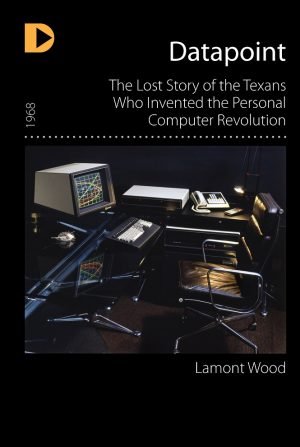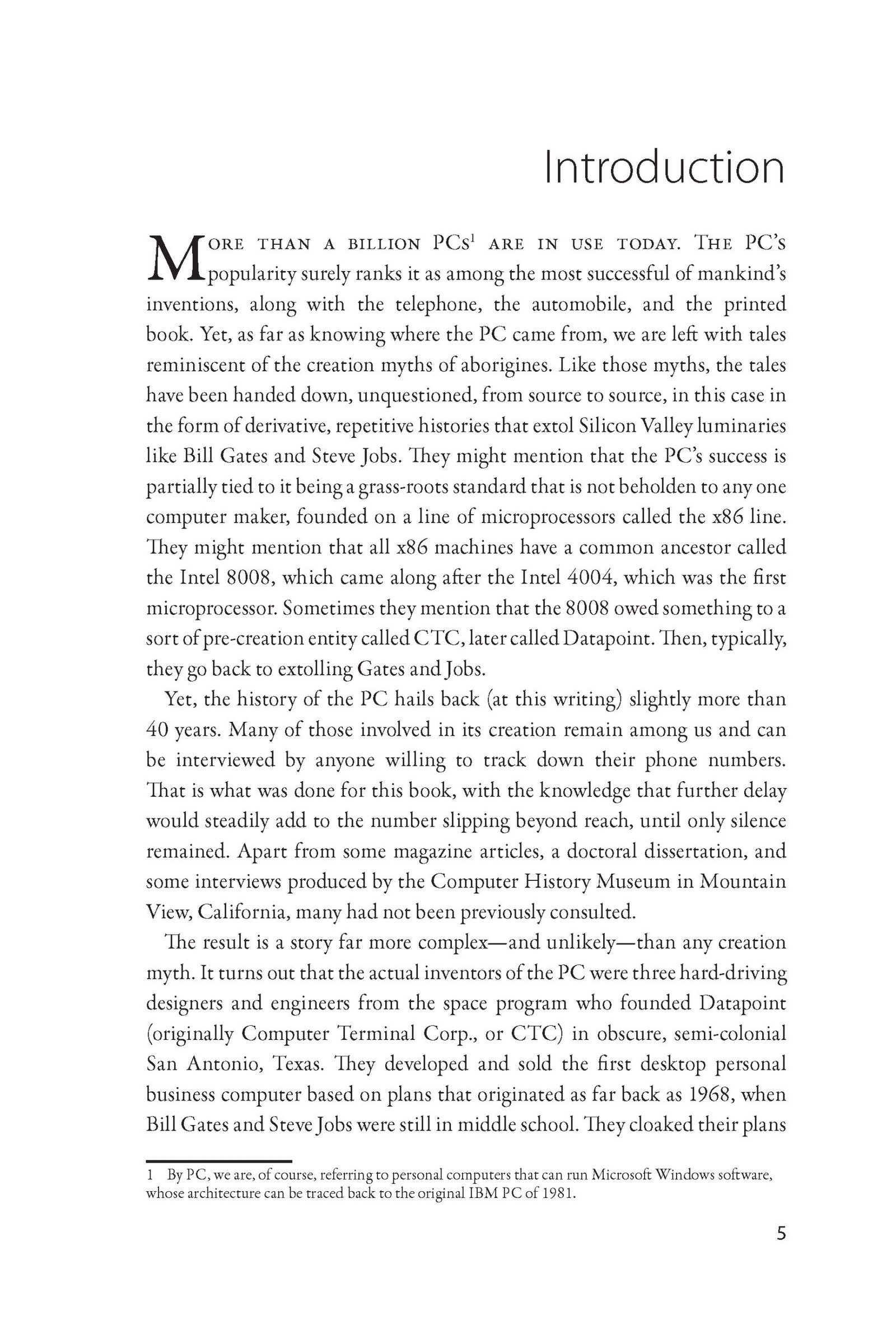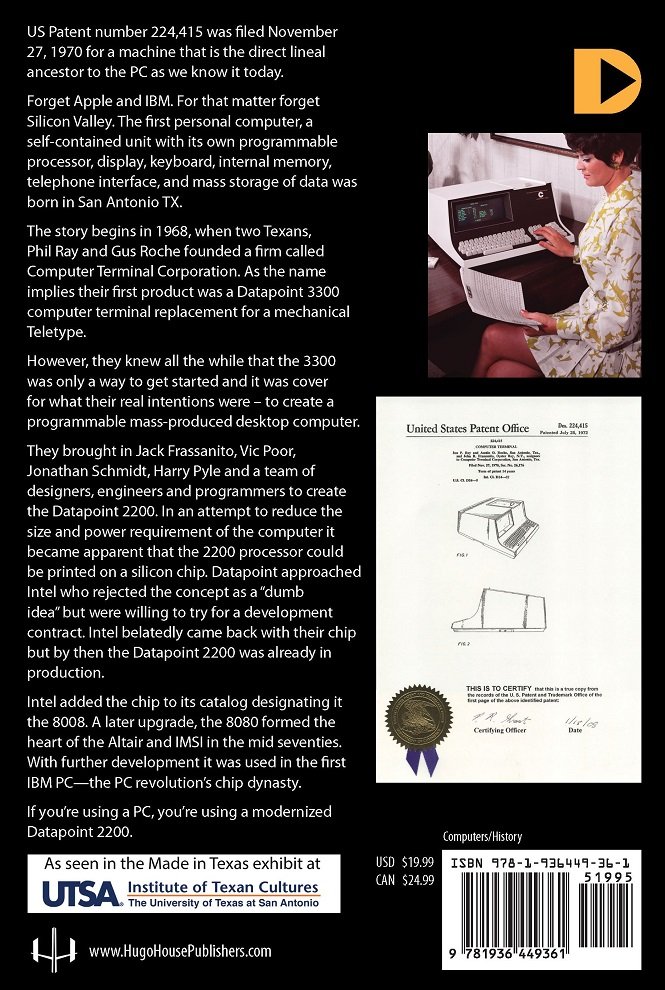Editorial Review
5.0 out of 5 stars Amazing Account of A Failed Company, January 11, 2013
By Richard D. Hilton
This review is from: Datapoint: The Lost Story of the Texans Who Invented the Personal Computer Revolution (Paperback)
Having worked for Computer Terminal Corporation in 1972, I personally saw the company through its brilliant rise up to the demise of the company. I left in 1992, but I saw the changes that resulted when an excellent company grew too fast, and the bad business decisions that resulted in the eventual demise of the company in 1996.
Datapoint was a remarkable company, and anyone who's interested in computers will want to hear what brought such an innovative company to its knees and resulted in it having to close.
It is sad that most of the original players are gone now, and one of the original people in the forming of the company (mentioned and a contributor of information in the book), Jack Frassanito, is still very much alive and kicking. These original founders were absolute geniuses who constructed a company at the right time and competed with the big boys at the time, IBM, DEC, and HP. Read the book and see how they did it.
Read this book and learn that the computer you're using is a direct descendent of the original Datapoint machine, and that Datapoint had a working and active LAN system working and in use by customers years before any other company did. How did the company lose this edge? Read the book and find out how they were unable to capitalize on this advantage.
I am fortunate to have two copies in my possession. One book, the larger hardback copy was presented to me by Mr. Frassanito. The soft cover version was given to me by Austin Roche, son of one of the original founders, Gus Roche.
Both books are of high quality print, but the hard cover version has glossy pages and much clearer pictures. The book features pictures of the players, and charts and other nice information that is logically laid out.
The only gripe, if you can call it that, is the dry manner the story is told. If you have a particular interest in Datapoint, you will, for sure, want a copy that lays out the history of a remarkable company. People will be surprised to learn that PCs and microprocessors were the idea of geniuses living in Texas of all places!
5.0 out of 5 stars The Real Story of the PC, January 2, 2013
By AOR
This review is from: Datapoint: The Lost Story of the Texans Who Invented the Personal Computer Revolution (Paperback)
Lamont provides insight about the true origin of the first integrated personal computer, washing away the incomplete lore and popular distortions that many in the computer industry have come to accept. It turns out to be more complex and interesting than is commonly understood by the public and most of those who worked on computer design during the 60's, 70s and 80's.
I believe this is the most informed and complete account written about Computer Terminal Corp/Datapoint Corp, the key role they played in creating the PC revolution and their sustained innovation and presence in the industry for decades. Lamont has done his research well, providing both corroborated facts and balanced assessment of areas where individual recollections differ.
If you want to really understand how mainframe and time share computing transitioned to the PC revolution and who the true players were, read Lamont's book. It is well written, interesting history, challenging to the status quo and valuable remembrance of how innovative individuals act in teams to build technology foundations that drive new world views.
5.0 out of 5 stars Such a great and unexpected story, April 2, 2014
By Gio (Italy)
This review is from: Datapoint: The Lost Story of the Texans Who Invented the Personal Computer Revolution (Paperback)
Such a great and unexpected story if you are interested in how PC and processors were born (aside mere myth, I mean !).
4.0 out of 5 stars A bit too narrow in scope., January 19, 2014
By Amazon Customer "DPM" (Seattle, WA ,USA)
This review is from: Datapoint: The Lost Story of the Texans Who Invented the Personal Computer Revolution (Kindle Edition)
Concentrates on the principals who started Datapoint. I am a former TRW Datapoint employee. I know there were a lot of other very interesting stories about Datapoint. I would have liked to see some of that richness woven in.
Some examples may include:
- Bill Wilbur starting TRW Canada in Toronto by marching up and down financial row with a CTOS system in a wagon.
- The incredible talent of Harry Pile creating the DOS operating system.
- Datapoint HASP, 3780, 2780 terminals that helped Canadian companies build national networks.
- TRW Datapoint banking solutions that sparked innovation in the Toronto financial community.
- TRW Datapoint initiatives at Walden University that lead to successful spinoff companies.
Maybe these are a bit out of scope and could become part of a second publication: Datapoint Its Influence on the Computer Industry. I think its influence was considerable on those that came after it such as Microsoft.
I can remember demonstrating Datapoint Datashare to companies that accused me of faking the demo because we showed them 8 terminals running in 16K. When they finally got it they were floored. What they were used to were rooms of equipment not the CTOS operating system that did the same thing.
5.0 out of 5 stars Worked for DPT for over ten years, July 23, 2013
By John A Gunther
This review is from: Datapoint: The Lost Story of the Texans Who Invented the Personal Computer Revolution (Paperback)
Well written and total coverage. The people I knew in the book are very well depicted. Book is extremely accurate.
4.0 out of 5 stars The Datapoint story - great book, July 5, 2013
By Jon Peddie - See all my reviews
This review is from: Datapoint: The Lost Story of the Texans Who Invented the Personal Computer Revolution (Paperback)
If someone told you the PC was actually invented in San Antonio, Texas, in 1968 while Bill Gates and Steve Jobs were still in middle school, would you believe them? Probably not, but in fact it was and led the then infant Intel Corporation into the development of their now famous 4004, the ancestral microprocessor of all PCs built since then. San Antonio, in the late 60s, imagine.
I ran a company in San Antonio in that era called Data Graphics Corporation. We were in competition with Datapoint, not for customers, but for engineers. They'd steal two from us, we'd take one from them. We sold DGC and moved to California. Datapoint stayed in San Antonio and went on to become a Fortune 500 leading technology company. They invented the Local Area Network, Video Conferencing, and, of course, the first PC -- except they didn't call it a PC, they called it the Datapoint 2200, a "glass" IBM card punch replacement.
Later I started another company, Jupiter Systems, to build graphics terminals. The industrial designer who designed our cabinets was none other than Jack Frassanito, the guy who was the industrial designer of the Datapoint 2200. Jack and I stayed friends over the years. When I mentioned to him I was writing a book (The History of Visual Magic in Computers) he suggested, no he demanded, I include Datapoint, and the 2200, and get it right about being the first effective PC. I'm glad he did, my book is the better for it--yet another debt to Jack.
If you have the slightest interest in the history of computers, and like a good story, this book was written for you. Lamont Wood started the project by writing an article for the San Antonio Light newspaper. His research sent him chasing after company documents and the founders, most of whom are dead now. That lead him to Jack. From there, a collaboration developed, sometimes tested and strained, but long-lasting because they both believed in the importance of the story.
Datapoint rose and then fell. Lamont has given us his analysis of how it occurred, but having started a few companies I can tell you it wears you out. And I think that was one of the contributors to the company's demise. The company is criticized for not adapting to changes in technology fast enough There were plenty in those days. But to do that you have to be willing to give up what you have already developed and be your own competitor--and that takes courage and stamina. I think the management just ran out of both.
Read Lamont's book and see what you think. One thing's for sure, you will be amazed at what Datapoint did, and how far ahead of every other company they were. It's an astonishing story, well written, easy to read, and full of facts and interesting anecdotes. And the bonus is, you can bring it up at parties and either look very smart, and/or win bets.
4.0 out of 5 stars Datapoint - The Company That Could Have Been, June 6, 2013
By Upstate New York Reader (New York)
This review is from: Datapoint: The Lost Story of the Texans Who Invented the Personal Computer Revolution (Paperback)
Though I do not remember hearing of Datapoint, I may have used one of their early systems before graduating from college. Regardless, this book was a interesting walk through computer history - including its technology, its people, and its business.
Datapoint started out knowing where it wanted to go, but dropped out of the race to get there just as it had the greatest opportunity. Its interaction with TRW, TI, and Intel, allowed it to give away the assets that were of greatest value - without knowing it was doing so. The politics of Datapoint's leaders kept it moving in the direction it was going - not able to change course even as technology was moving around them.
The book was interesting - yet it did not have the mystery and suspense that can be found in other books describing the people and companies that defined early computer history. It provided the background and story of a company that could have been, but was not able to gain the greatness that could have been theirs. As it allows the reader insight into the early years that defined the personal computer, it would be an excellent book as an ancillary book for students enrolled in freshman Computer Science courses - whether within the major or in a service course.
______________
This review is based on a free electronic copy of this book provided by the publisher for the purpose of creating this review. The opinions expressed are mine alone.
4.0 out of 5 stars Lived that one, May 1, 2013
By Glenwood
This review is from: Datapoint: The Lost Story of the Texans Who Invented the Personal Computer Revolution (Paperback)
I worked there for 16 years and saw much of what was written. Really enjoyed my years there. Too bad it ended.
5.0 out of 5 stars Datapoint -History That Is Long Over Due, April 1, 2013
By RochePhoto
This review is from: Datapoint: The Lost Story of the Texans Who Invented the Personal Computer Revolution (Paperback)
A comprehensive history of Datapoint Corp. has been long over due! The Datapoint story, in its own way is as seminal as the stories of Apple and Fairchild for it's influence and impact on the computer revolution that is now a ubiquitous part of are lives. The audacity of Gus Roche, Phil Ray, and Jack Frassanito in particular, to set out with just a few thousand dollars to implement bold and revolutionary ideas, set the computing world on its ear. The founders and a host of hired guns pushed beyond the limits of the computing field at the time. It was a shame that a company with such a meteoric rise and such great potential died in obscurity. Perhaps if the founders and their creative spirit had survived we would be looking at a story yet to be completed. This is a must read for anyone interested in Technology History and is compelling as well, for those who love a great story of underdogs and innovation showing the big boys the way forward.
Kudos to Lamont Wood for taking this one on and bringing it to light!
































Reviews
There are no reviews yet.